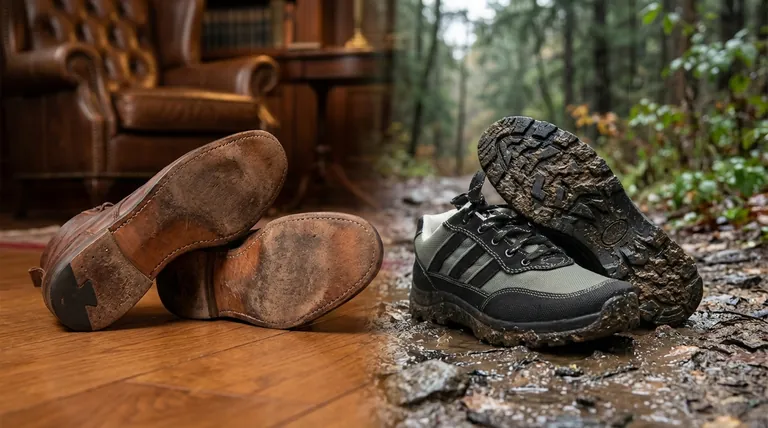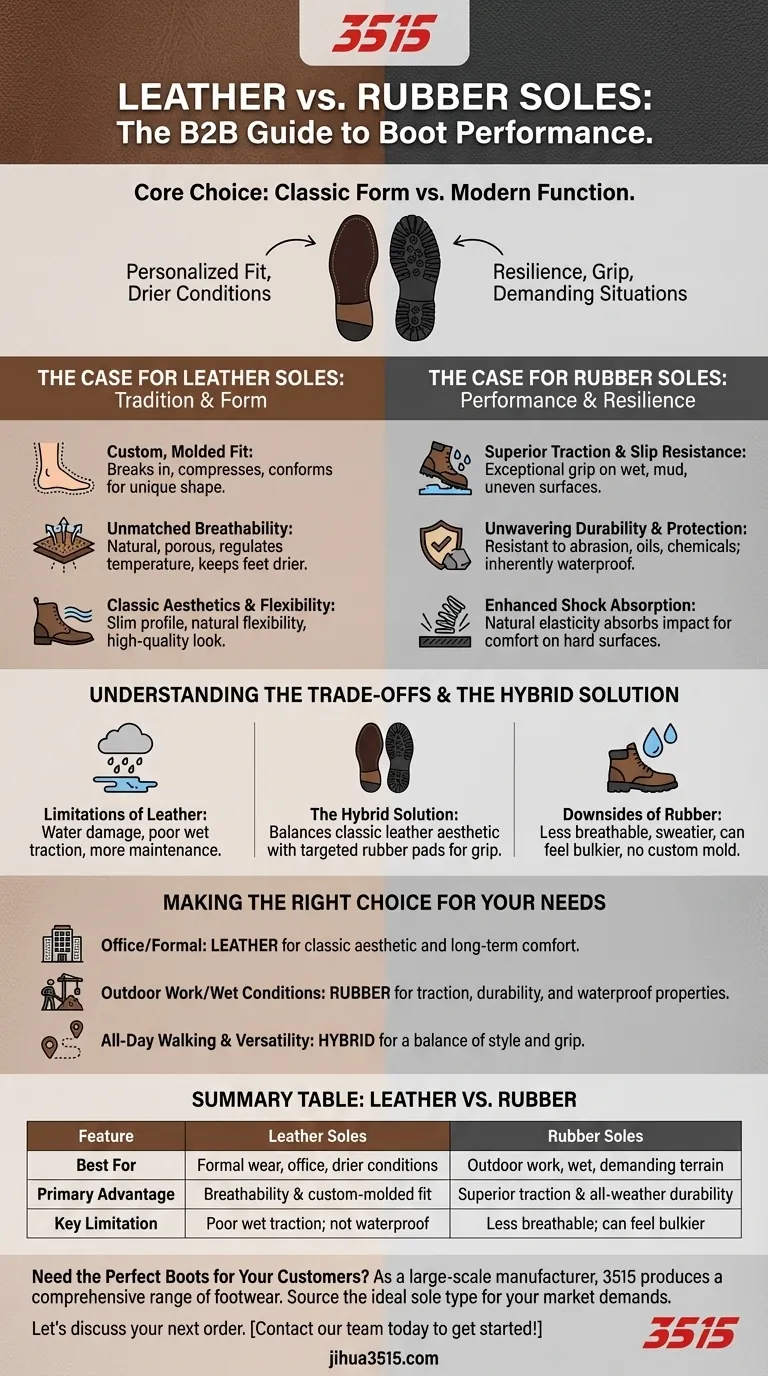At its core, the choice between leather and rubber soles is a decision between classic form and modern function. Leather soles offer unparalleled breathability and the ability to mold perfectly to your foot over time, while rubber soles provide superior traction, durability, and protection from the elements.
The decision isn't about which sole material is universally "better," but which is the right tool for your specific environment and purpose. Leather excels in creating a personalized, comfortable fit for drier conditions, whereas rubber is engineered for resilience and grip in demanding situations.

The Case for Leather Soles: Tradition and Form
Leather has been the traditional material for footwear for centuries for good reason. Its primary advantages are tied to its natural properties, which focus on comfort and a classic aesthetic.
A Custom, Molded Fit
The most celebrated characteristic of a leather sole is its ability to break in. Over time, it compresses and conforms to the unique shape of your foot, creating a truly custom fit that is difficult to replicate with synthetic materials.
Unmatched Breathability
As a natural, porous material, leather allows air and moisture to pass through. This breathability helps regulate temperature and reduces sweat buildup, keeping your feet drier and more comfortable throughout the day, especially in office environments.
Classic Aesthetics and Flexibility
Leather soles offer a slim, elegant profile that is the hallmark of high-quality dress shoes and boots. They provide a natural flexibility that allows for a comfortable walking motion once broken in.
The Case for Rubber Soles: Performance and Resilience
Rubber soles were developed to overcome the natural limitations of leather. Their advantages center on durability, grip, and protection, making them ideal for work, weather, and challenging terrain.
Superior Traction and Slip Resistance
This is rubber's most significant advantage. The material and its typical tread patterns provide exceptional grip on a wide variety of surfaces, including wet pavement, mud, and uneven ground, significantly reducing the risk of slips.
Unwavering Durability and Protection
Rubber is highly resistant to abrasion, meaning it wears down much more slowly on rough surfaces like concrete. It is also inherently waterproof and often resistant to oils and chemicals, making it the standard for work boots and foul-weather gear.
Enhanced Shock Absorption
The natural elasticity of rubber allows it to absorb impact far more effectively than leather. This provides significant comfort for those who spend long hours walking or standing on hard surfaces.
Understanding the Trade-offs
Neither material is perfect for every situation. Being aware of their inherent limitations is key to making an informed decision.
The Limitations of Leather
Leather's greatest weakness is water. Excessive moisture can damage the material, and it offers very poor traction on wet surfaces. Leather soles also require more maintenance and a longer break-in period.
The Downsides of Rubber
Rubber is not as breathable as leather, which can lead to warmer, sweatier feet in some conditions. While durable, it does not mold to the foot in the same customized way and can feel bulkier and less flexible than a well-worn leather sole.
The Hybrid Solution
Many modern boots feature hybrid soles. These often combine the classic look of a leather midsole with targeted rubber pads on the heel and forefoot, offering a balance between the aesthetic of leather and the practical grip of rubber.
Making the Right Choice for Your Needs
Select your sole based on how and where you will spend the majority of your time wearing the boots.
- If your primary focus is office wear or formal events: Choose leather soles for their classic aesthetic and ability to mold to your foot for long-term comfort.
- If your primary focus is outdoor work or navigating wet conditions: Opt for rubber soles for their unmatched traction, durability, and waterproof properties.
- If your primary focus is all-day walking and versatility: Consider a hybrid sole that combines a leather profile with rubber traction pads for a balance of both worlds.
Ultimately, matching the sole's inherent strengths to your daily demands ensures your boots will serve you well for years to come.
Summary Table:
| Feature | Leather Soles | Rubber Soles |
|---|---|---|
| Best For | Formal wear, office environments, drier conditions | Outdoor work, wet conditions, demanding terrain |
| Primary Advantage | Breathability & custom-molded fit over time | Superior traction & all-weather durability |
| Key Limitation | Poor traction on wet surfaces; not waterproof | Less breathable; can feel bulkier |
Need the Perfect Boots for Your Customers?
As a large-scale manufacturer, 3515 produces a comprehensive range of footwear for distributors, brand owners, and bulk clients. Our production capabilities encompass all types of shoes and boots, allowing you to source the ideal sole type—leather, rubber, or hybrid—for your specific market demands.
Let's discuss your next order and how we can deliver the quality, durability, and style your customers expect.
Contact our team today to get started!
Visual Guide

Related Products
- Durable Rubber-Soled Utility Shoes for Wholesale & Custom Brand Manufacturing
- Safety Footwear Wholesale Manufacturer for Custom OEM/ODM Production
- Premium Flame-Retardant Waterproof Safety Boots and Shoes
- Premium Wholesale Tactical Style Safety Shoes Boots with Quick Lacing
- Wholesale Premium Waterproof Nubuck Safety Shoes Boots
People Also Ask
- What makes rubber sole shoes an economical and practical choice? Unmatched Durability & All-Weather Value
- What historical breakthrough in 1844 contributed to modern shoe sole manufacturing? The Vulcanization Revolution
- What are rubber soled shoes? The Ultimate Guide to Durable, All-Weather Footwear
- What is vulcanized rubber and why is it used in products? The Key to Durable, Flexible Footwear
- Why should we wear rubber soled shoes? Unlock Superior Safety and Durability



















